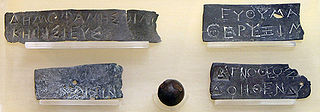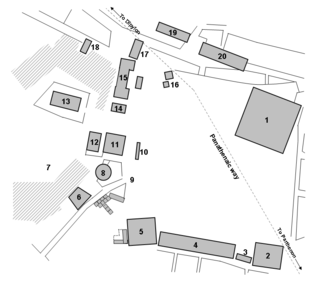Related Research Articles

Aristides was an ancient Athenian statesman. Nicknamed "the Just", he flourished in the early quarter of Athens' Classical period and is remembered for his generalship in the Persian War. The ancient historian Herodotus cited him as "the best and most honourable man in Athens", and he received similarly reverent treatment in Plato's Socratic dialogues.
The Thirty Tyrants were a pro-Spartan oligarchy installed in Athens in 404 BC, after the Athenian democracy had been defeated by Sparta in the Peloponnesian War. Upon Lysander's request, the Thirty were elected as a tyrannical government, not just as a legislative committee. Although they maintained power for only a brief eight months, their reign resulted in the killing of 5% of the Athenian population, the confiscation of citizens' property and the exile of other democratic supporters. They became known as the "Thirty Tyrants" because of their cruel and oppressive tactics. The two leading members were Critias and Theramenes.
In cities of ancient Greece, the boule was a council of 500 citizens appointed to run daily affairs of the city. Originally a council of nobles advising a king, boulai evolved according to the constitution of the city: In oligarchies boule positions might have been hereditary, while in democracies members were typically chosen by lot and served for one year. Little is known about the workings of many boulai, except in the case of Athens, for which extensive material has survived.

The ancient Agora of Athens is the best-known example of an ancient Greek agora, located to the northwest of the Acropolis and bounded on the south by the hill of the Areopagus and on the west by the hill known as the Agoraios Kolonos, also called Market Hill. The Agora's initial use was for a commercial, assembly, or residential gathering place.

In Ancient Greece, a deme or demos was a suburb or a subdivision of Athens and other city-states. Demes as simple subdivisions of land in the countryside seem to have existed in the 6th century BC and earlier, but did not acquire particular significance until the reforms of Cleisthenes in 508 BC. In those reforms, enrollment in the citizen-lists of a deme became the requirement for citizenship; prior to that time, citizenship had been based on membership in a phratry, or family group. At this same time, demes were established in the main city of Athens itself, where they had not previously existed; in all, at the end of Cleisthenes' reforms, Athens was divided into 139 demes. Three other demes were created subsequently: Berenikidai, Apollonieis, and Antinoeis. The establishment of demes as the fundamental units of the state weakened the gene, or aristocratic family groups, that had dominated the phratries.
Phyle is an ancient Greek term for tribe or clan. Members of the same phyle were known as symphyletai, literally: fellow tribesmen. They were usually ruled by a basileus. Some of them can be classified by their geographic location: the Geleontes, the Argadeis, the Hopletes, and the Agikoreis, in Ionia; the Hylleans, the Pamphyles, the Dymanes, in the Dorian region.

The trittyes, singular trittys were part of the organizational structure the divided the population in ancient Attica, and is commonly thought to have been established by the reforms of Cleisthenes in 508 BC. The name trittys means "third", and is named such because there were three types of regions in each trittys. There were thirty trittyes and ten tribes named after local heroes in Attica. Trittyes were composed of one or more demes; demes were the basic unit of division in Attica, which were the smaller units of population that made up the trittyes..

Stoa Basileios, meaning Royal Stoa, was a stoa constructed in Ancient Athens in the 6th century BC and substantially altered in the 5th century BC. It was located in the northwest corner of the Athenian Agora.
Laches was an Athenian aristocrat and general during the Peloponnesian War.
Acamantis was one of the phylai (tribes) of classical Athens, created during the reforms of Cleisthenes. It was named after the legendary hero Acamas, and included the demes of Cholargos, Eiresidai, Hermos, Iphistiadai, Kerameis, Kephale, Poros, Thorikos, Eitea, Hagnous, Kikynna, Prospalta and Sphettos.
Susan Irene Rotroff is an American classical archaeologist, classicist, and academic, specialising in the art, archaeology, and pottery of Ancient Greece. She was Jarvis Thurston and Mona Van Duyn Professor in the Humanities, at Washington University in St. Louis.
Alopece was an asty-deme of the city of Athens, but located exterior to the city wall of Athens. Alopece was situated only eleven or twelve stadia from the city, and not far from Cynosarges. It possessed a temple of Aphrodite, and also apparently one of Hermaphroditus.
Aiantis was a phyle of ancient Attica with six demes, the deme with the greatest area was Aphidna.
Erechtheis was a phyle (tribe) of ancient Athens with fourteen demes.
Aigeis was a tribe (phyle) of Ancient Athens which contained twenty demes.
Pandionis is a phyle of ancient Attica, which had eleven demes at the time of its creation, which is when the phyle was created as part of a group of ten phylai.
Upper Ancyle or Ankyle Kathyperthen was the name of a deme of ancient Attica. It was located east of Athens and bordering Agryle to the south. Upper Ancyle passed from the phyle Aigeis to Antigonis in 307/306 BCE; Lower Ancyle remained in the Aigeis phyle.
Lower Ancyle or Ankyle Hypenerthen was the name of a deme of ancient Attica. It was located east of Athens and bordering Agryle to the south. Upper Ancyle passed from the phyle Aigeis to Antigonis in 307/306 BCE; Lower Ancyle remained in the Aigeis phyle.
Daedalidae or Daidalidai was a deme of ancient Attica, located north of Alopece, southeast of Athens. The name "Daedalidae" was often used to refer to the most skilled sculptors an allusion to Daedalus, the labyrinth builder of Knossos. Socrates, in two dialogues of Plato, claims to descend from Daedalus, most likely exploiting this allusion, in which his ancestors would have been sculptors. In Daedalidae, therefore, a craftsman named Daedalus could have been revered as an eponymous hero, which was most probably not the same as the Daedalus of mythology. Some sources note the presence of a sanctuary called Dedaleion.
Ptelea was a deme of ancient Attica of the phyle Oineis, sending one delegate to the Athenian Boule. It is the setting for Menander's Heros.
References
- ↑ E Vanderpool - Studies in Attic Epigraphy, History, and Topography: Presented to Eugene Vanderpool (p.170) ASCSA, 1982 ISBN 0-87661-519-1 [Retrieved 2015-04-17]
- ↑ NF. Jones - Ionian tribes DOI: 10.1002/9781444338386.wbeah04146 Published Online: 26 OCT 2012 The Encyclopedia of Ancient History[Retrieved 2015-04-17](ed. for nature of word < phylai >)
- ↑ N Fikri Alican - Rethinking Plato: A Cartesian Quest for the Real Plato (p.331) Rodopi, 2012 ISBN 94-012-0812-3 [Retrieved 2015-04-17]
- ↑ R Hunter (Regius Professor of Greek at the University of Cambridge c.2005) - The Hesiodic Catalogue of Women: Constructions and Reconstructions (p.191) Cambridge University Press, 14 Jul 2005 (reprint) ISBN 978-0-521-83684-5, 349 pages [Retrieved 2015-04-17]
- ↑ Papazarkadas, Nikolaos (2011). Sacred and Public Land in Ancient Athens. OUP Oxford. p. 295. ISBN 978-0-19-969400-6.
- ↑ John S. Traill The Political Organization of Attica: A Study of the Demes, Trittyes, and Phylai, and Their Representation in the Athenian Council, Volumes 14-16 (p.13) ASCSA, 1975 ISBN 0-87661-514-0 [Retrieved 2015-04-17]
- ↑ O Palagia, A Spetsieri-Choremi - The Panathenaic Games: Proceedings of an International Conference held at the University of Athens, May 11-12, 2004 (p.77) Oxbow Books, 26 Feb 2015 ISBN 1-78297-985-9 [Retrieved 2015-04-17]
- ↑ John S. Traill - (same source as given previously here)[Retrieved 2015-04-17]
- ↑ J Robinson (D.D., Rector of Clifton, Westmoreland.) - Archaeologia Graeca, or the Antiquities of Greece; chiefly designed to illustrate the Greek Classics. To which are prefixed, a brief history of the Grecian States, and biographical sketches of the principal Greek writers 1827 [Retrieved 2015-04-17]
- ↑ Nails, D - "Socrates" - A Chronology of the historical Socrates in the context of Athenian history and the dramatic dates of Plato's dialogues The Stanford Encyclopedia of Philosophy (Spring 2014 Edition), Edward N. Zalta (ed.)[Retrieved 2015-04-17]
- 1 2 Plato (2015). "Apology". In PL Miller; CDC Reeve (eds.). Introductory Readings in Ancient Greek and Roman Philosophy. Translated by Reeve. Hackett Publishing. p. 72. ISBN 978-1-62466-354-3 . Retrieved 2015-04-17.
- ↑ Oxford Dictionary - prytany Oxford University Press [Retrieved 2015-04-17]
- ↑ M Dillon, L Garland (lecturer in Classics and Ancient History at the University of New England, New South Wales) - Ancient Greece: Social and Historical Documents from Archaic Times to the Death of Alexander (p.119) Routledge, 18 Jun 2010 ISBN 1-136-99138-7 (revised) [Retrieved 2015-04-17]
- ↑ N Sekunda (Ph.D 1981, taught at the Institute of Archaeology and Ethnology in Torun, Poland c.2002) - 490 BC: The First Persian Invasion of Greece (p.53) Archived 2016-03-06 at the Wayback Machine Osprey Publishing, 2002 ISBN 1-84176-000-5 [Retrieved 2015-04-17]